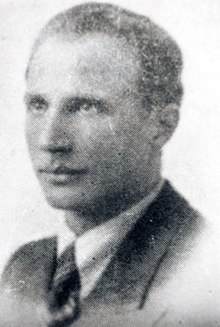|
Vasyl Sydor
Vasyl Sydor (Ukrainian: Василь Сидор; 24 February 1910 – 14 April 1949) was a colonel of the Ukrainian Insurgent Army (UPA), political activist, soldier of the Nachtigall Battalion, commandant of Schutzmannschaft Battalion 201, vice-commander of UPA and leader of UPA-West for Eastern Galicia during World War II. Sydor was killed in combat with Soviet troops in the Limnytsia river valley.[1] Political significanceOn 1 September 1944, Vasyl Sydor (Shelest) as the UPA commander for Eastern Galicia, issued an order to end "mass anti-Polish actions" within the borders of postwar Poland, thereby focusing on resistance rather than ethnic cleansing.[2] Murders of civilians continued, but only in retaliation.[3] From then on, UPA units began concentrating on attacking those who served with the pro-Soviet forces (although it took several months for the orders to reach individual commanders in the field).[2] In 1945 the Home Army issued a manifesto calling for an end to fighting between Poles and Ukrainians and for cooperation, printed it in 7,500 copies and distributed it in the surrounding villages.[4] At the same time, the leadership of UPA in the region made similar moves aimed at the same goal. After mediation by Catholic and Eastern Orthodox clergy, a meeting was arranged in Puszcza Solska (Solska Forest) between the commanders of both groups.[4] The top commander on the Polish side was Marian Gołębiewski (Ster) and on the Ukrainian side Jurij Lopatynsky (Szejk).[2] On the night of 27 May 1946 the Home Army and UPA conducted their one-and-only joint operation against the communist forces of UB and NKVD in Hrubieszów. They parted their ways the next morning after a successful attack.[2] References
|
||||||||||||||||||||
